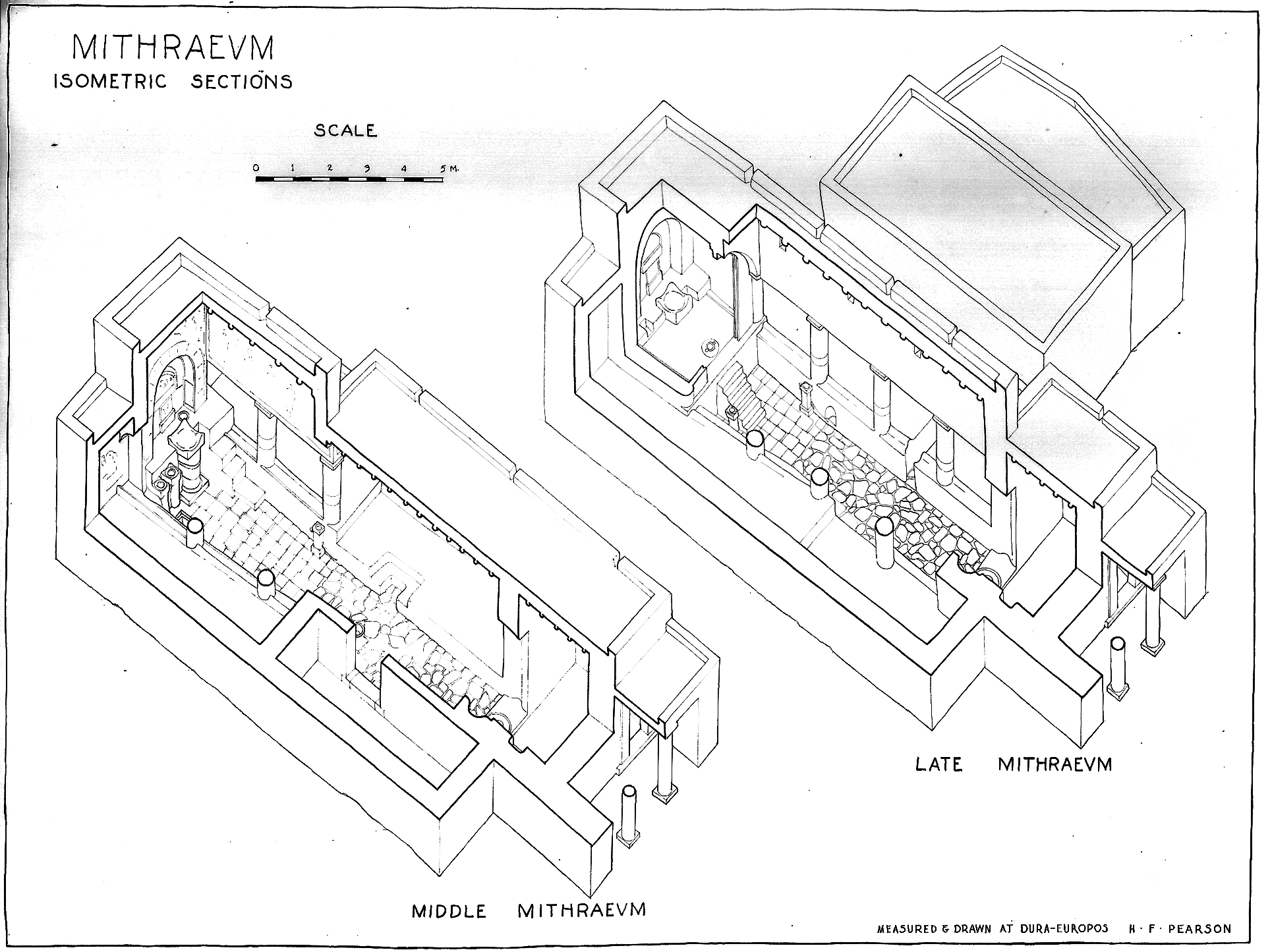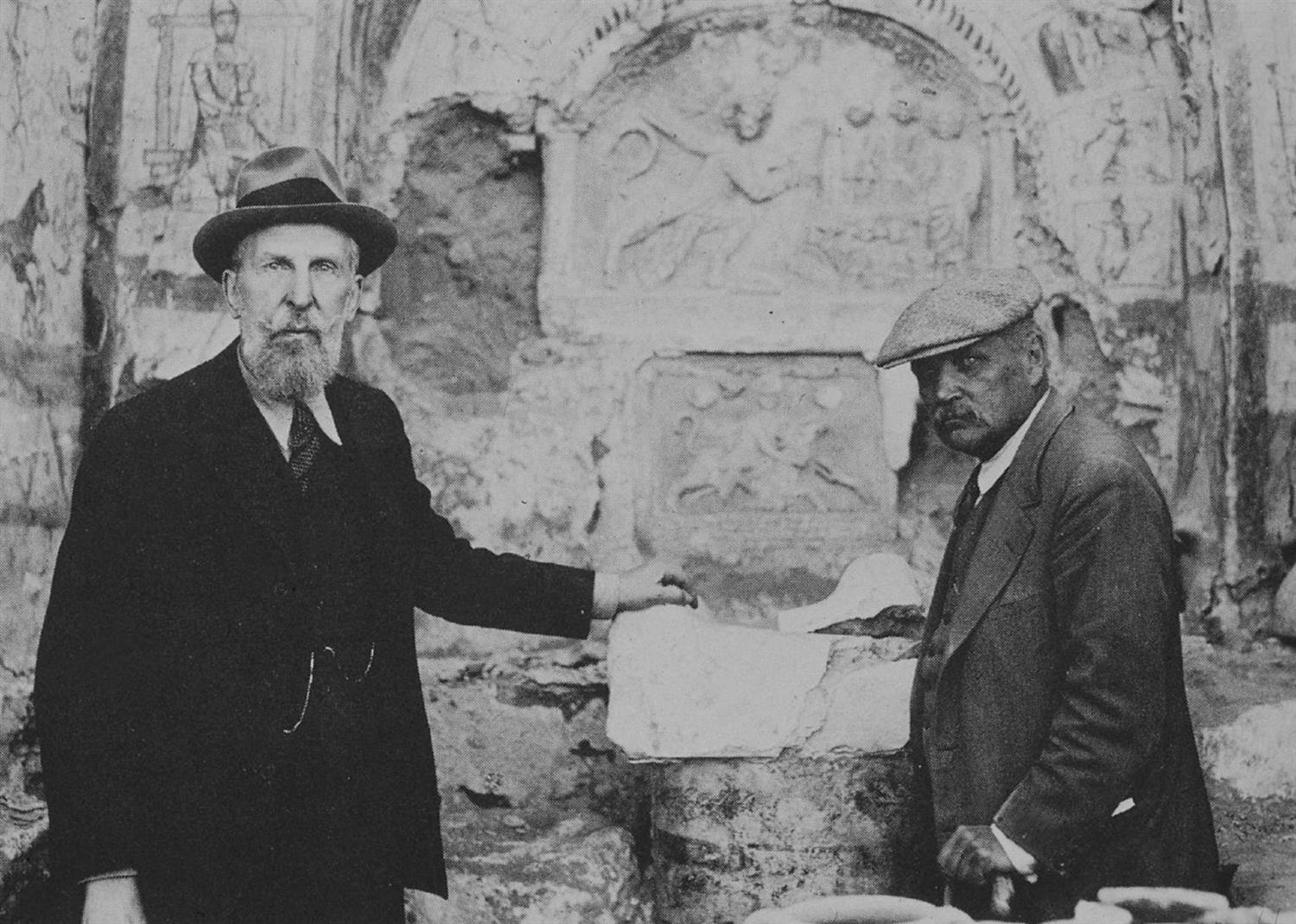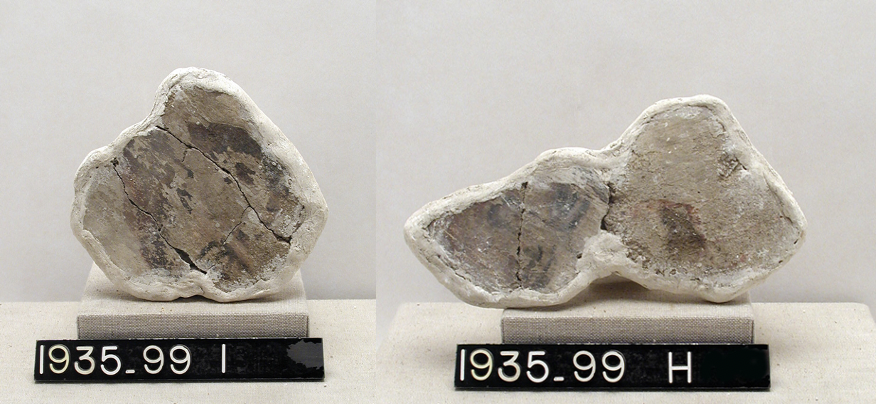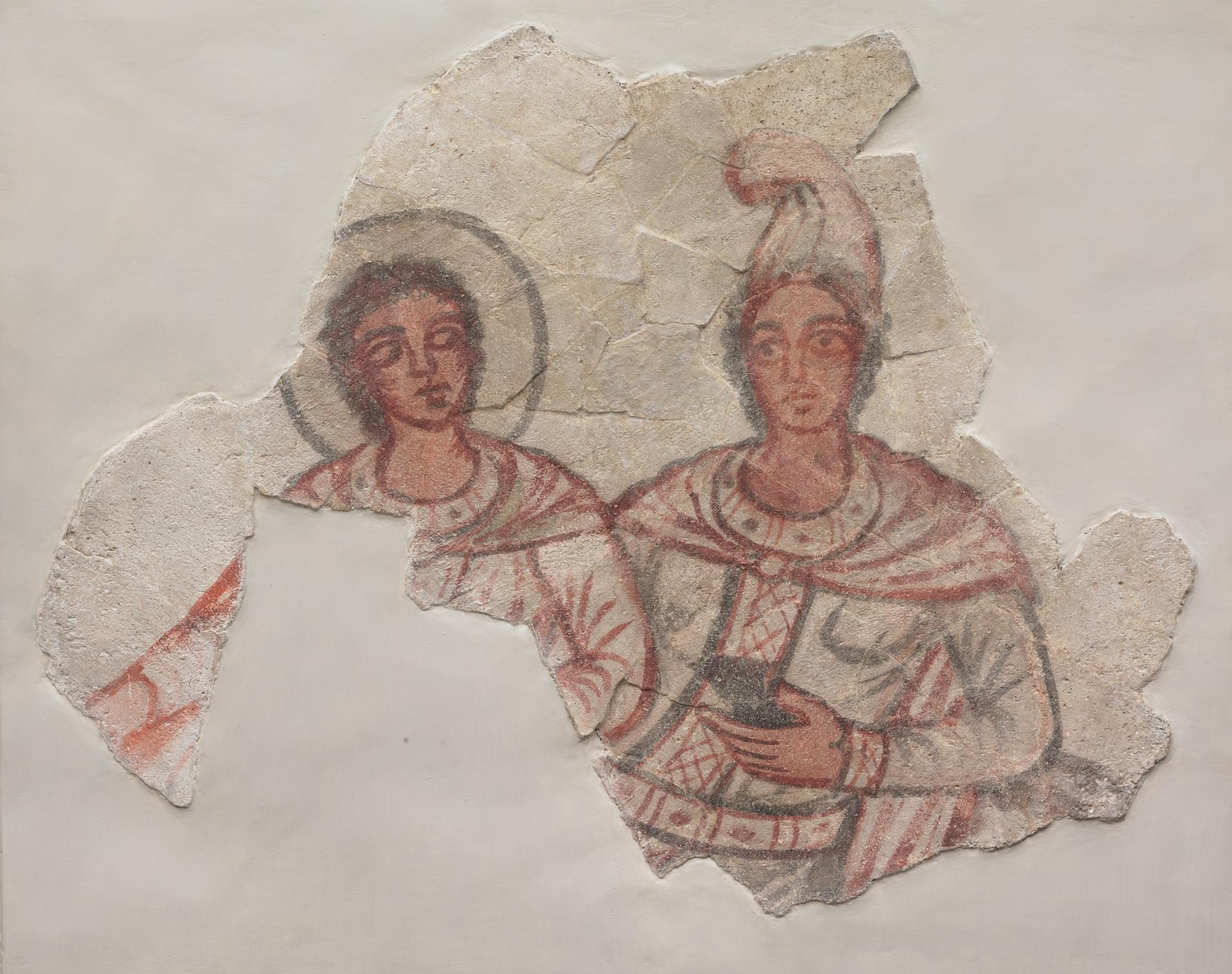Interpretations and Construction
The images used to model and annotate this project were primarily based off of objects currently stored at the Yale University Art Gallery, excavated by the Yale-French Excavations at Dura Europos.
Led in large part by Henry Pearson, found the shrine of this mithraeum almost entirely intact. Pearson’s three stages of construction of the Mithraeum were called the Early Mithraeum (EM), Middle Mithraeum (MM), and Late Mithraeum (LM). What is on display at the Yale University Art Gallery is a part of the Late Mithraeum known as the shrine. As mentioned, this three stage interpretation comes from—and has been subsequently published and canonized—Henry Pearson and Mikhail Rostotzeff, with the three stages loosely defined here:
Early Mithraeum: this stage of construction centered around the shrine, which was at the time housed in a private home, instead of a building built for worship. Made up of a single room, the space opens off of a courtyard, with benches on either side of it. Importantly, Pearson’s interpretation asserts that there is no significant decoration such as the plaster paintings traditional to the Mithraeum in place during the EM.
Middle Mithraeum: this stage included an expansion of the EM into its own building, with a new entrance, space of worship (specifically the benches) expanded from the original room. Notably, an arch framing the cult image and elaborate paintings decorated the walls of the Middle Mithraeum.
Late Mithraeum: this stage primarily included an expansion of the functional elements erected during the MM, including an earlier staircase, altars, and an expansion of the ceiling. These new constructions partially covered some of the painting from the MM, and some reliefs were re-set because of this. There is also evidence of an overall new decorative program assigned to this stage.

On the other hand, Dirvin and McCarthy propose thinking of the phases in the phases of Mithraeum I (loosely EM and MM) and Mithraeum II (LM), with a shifted timeline that does not exactly follow the years that Pearson ascribed to the different stages. They argue for a re-interpretation that evaluates a more complex and less delineated history of the Mithraeum, and one that accounts for the impact that earlier versions and decorative programs of the building might have had on later constructions. This type of delineation, as formerly mentioned, does not allow for a cross-temporal analysis of the decoration and fragments excavated from the Mithraeum that Dirvin and McCarthy suggests. This project then aims to visualize objects from the Mithraeum and its shrine categorized by stage in order to see how the shrine and building evolved in Dura Europos. However, both Pearson’s and Dirvin and McCarthy’s interpretations are taken into account in our project, as we acknowledge both the EM, MM, and EM, as well as Mithraeum I and II in order to give a full picture of both interpretations.
Cult Relief of Mithras Slaying the Bull (Tauroctony) Larger
Description: The Mithraeum at Dura-Europos is unique in featuring two cult reliefs (see 1935.97) of Mithras slaying the bull (the tauroctony) in the center of the niche. In both, the god appears in his customary pose—plunging a dagger into the bull’s throat—accompanied by the usual symbolic attendants: a raven, dog, snake, sun, and moon. In this later, larger relief, the dedicant and fellow initiates are depicted to one side. Although dedicants and family members appear in cult images elsewhere at Dura-Europos and at Palmyra, such iconography is extremely rare in Mithraic images. Greek inscription, was dedicated by Zenobius, also strategos of the archers, in year 482 [170-171 CE] do not deviate significantly from similar scenes in the West, nor do certain minor changes made in the reliefs testify to an adaptation to common Roman practice. Only the two reliefs that are dated to 169 and 170 CE can with certainty be ascribed to the first years of the Mithraic community.(limestone, phase I and II)
Location in Mithraeum: Part of shrine.
Cult Relief of Mithras Slaying the Bull (Tauroctony) Smaller
Description: The Mithraeum at Dura-Europos is unique in featuring two cult reliefs of Mithras slaying the bull (the tauroctony) in the center of the niche. In both, the god appears in his customary pose—plunging a dagger into the bull’s throat—accompanied by the usual symbolic attendants: a raven, dog, snake, sun, and moon. In the later, larger relief, the dedicant and fellow initiates are depicted to one side (see 1935.98). Although dedicants and family members appear in cult images elsewhere at Dura-Europos and at Palmyra, such iconography is extremely rare in Mithraic images. It has a Palmyrene inscription, which was dedicated by Ethpeni, strategos in charge of the archers at Dura, in the month of Adar, year 480 of the Seleucid era: spring of 169 CE. It does not deviate significantly from similar scenes in the West, nor does certain minor changes made in the reliefs testify to an adaptation to common Roman practice. Only the two reliefs that are dated to 169 and 170 CE can with certainty be ascribed to the first years of the Mithraic community. (limestone, phase I and II)
Location in Mithraeum: Part of shrine.
Pictures of the twelve signs of the zodic
Description: The series starts at the top of the vault and has to be read counterclockwise. Two male figures in Persian dress sit on either side of the piers of the niche. Above these two figures, the upper part of the outer surface of the arch is decorated with Mithras slaying the bull in the center, with the figure of Cautes with raised torch to Mithras' right. To Mithras' left we may recon- struct his twin brother Cautopates with lowered torch. On either side of this group are seven cypress trees, alternating with seven altars. In the midst of the foliage of the tree next to Cautopates, the small figure of a naked child protrudes. On the side walls of the raised shrine, on either side of the niche, are two paintings of a figure in Par- thian dress on horseback hunting animals. The painting on the south wall is best preserved and pictures the hunter moving towards the niche, whereas the figure on the north wall is galloping away from the niche. (paint on plaster, phase II)
Location in Mithraeum: Part of Shrine: The soffit of the vaulted niche.

Altar
Description: The altar table, about 0.16m. higher than the benches and 0.41m. deep,stood against the west wall, behind the large altar in the center, the two smaller altars to the south, and the stair to the north. The surface of the table presented two levels. The higher portion on the north, ran 0.14m. beyond the stair line and the southern portion continued, at a lower level, to the south bench, which, first curving slightly away,turned back at the same level to meet it. This lower portion may have served the same purpose as the box found in the same position in the Middle and Late Mithreaum. (limestone, phase I and II)
Possible location in Mithraeum: Part of shrine.
A Latin inscription (no image/model)
Description:It was for commemorating the rebuilding of a temple to Mithras with imperial titulature, found in the fill of the 256 CE siege rampart over the building, provides a date of 209-211 CE. (paint on plaster, phase II)
Possible location in Mithraeum: Western end of the Mithraeum.
A large tauroctony (no image/model)
Description:Part of the bull's rump and testicles as well as the head of the serpent were found in situ above the arch. Dirven argued, "Unfortunately, not illustrated and described very briefly, hence it is not clear whether this scene belongs to the early or later phase. The two heads with Phrygian cap are certainly early. We might possibly therefore have to reconstruct two successive tauroctony scenes." (paint on plaster, phase I)
Possible location in Mithraeum: Above the arch.
Two beardless figures with Phrygian caps
Description: A narrative scene in addition to the banquet (paint on plaster, phase I)
Possible location in Mithraeum: This narrative cycle was most likely set around the arch.
Another head of Sol
Description: A narrative scene in addition to the banquet. A head in three-quarter view in the same style with the same dimensions. (paint on plaster, phase I)
Possible location in Mithraeum: This narrative cycle was most likely set around the arch.
The upper part of the body of a figure in Parthian dress, turned to the left
Description: The fragment is 0.53 m. high and 0.55 m. wide. The height of the total figure may be estimated at 0.90 m. This is too big to match the head with Phrygian cap (above) and does not fit in the reveal of the niche. (paint on plaster, phase I)
Possible location in Mithraeum: This narrative cycle was most likely set around the arch.
A large fragment with Parthian clothing
Description: Fragment is 0.32 x 0.42 and probably is the lower part of the tunic. If correct, the height of this figure was about 1.00m. (paint on plaster, phase I)
Possible location in Mithraeum: This narrative cycle was most likely set around the arch.
A fragment of a bull's head
Description: A narrative scene in addition to the banquet. Pearson identifies the bull as belonging to the tauroctony above the arch, but the fragment suggests the animal faced frontally, which is highly unusual for a bull-killing scene. (paint on plaster, phase I)
Possible location in Mithraeum: This narrative cycle was most likely set around the arch.

Two fragmentary clean-shaven portraits
Description: These two portraits wearing Phrygian caps, now in storage at Yale, possibly belonged to this scene as well. They are painted in the same style as the narrative cycle surrounding the arch. The iconography suggests we are dealing with representations of Mithras or, more plausibly (since they are two near-identical portraits), the two torch bearers. According to Pearson, the central group was flanked on either side by at least one tree. (paint on plaster, phase I)
Possible location in Mithraeum: This narrative cycle was most likely set around the arch.
A crouching figure
Description:A crouching figure wearing tunic and trousers, above which are the feet of two other figures. (paint on plaster, phase I)
Possible location in Mithraeum: This narrative cycle was most likely set around the arch.
A fragment with the same dimensions as the scenes from the final phase
Description: This was painted in a style deviating from both the earliest and the last cycle. (paint on plaster, phase I)
Possible location in Mithraeum: This narrative cycle was most likely set around the arch.
Faint remains of five signs of the zodiac (no image/model)
Description: Pisces was the only recognizable one. The border of this series was yellow, the background blue, and the figures were in red and white. (paint on plaster, phase I)
Possible location in Mithraeum: Inside the cult niche, around the two bas-reliefs.
A reclining figure whose head was projecting into the border of the panel
Description: The scene is similar to the so-called sleeping Kronos from the last cycle. (paint on plaster, phase I)
Possible location in Mithraeum: On the left side of the niche, next to the bottom.
Several painted stucco fragments
Description: They display various styles that with one possible exception do not tally with the style of the paintings around the niche. Pearson writes about portraits of donors, some of which are identified by inscriptions, whereas on p. 104 he mentions three portraits of about the same large scale. It is not clear whether these are the donor portraits or different portraits. (paint on plaster, phase I)
Possible location in Mithraeum: In the nave.
Fragments of the portraits of Mithraic initiates: Head of Donor with Head at Right: Archelaus
Description: Several painted stucco fragments with a motif in red and black. (paint on plaster, phase I and II)
Possible location in Mithraeum: Attached to the larger cult relief.

The banquet of Mithras and Sol
Description: Since part of this painting was found covered by the newly constructed spelaeum of the last building phase, we know for certain that it belongs to the phase preceding the final decoration. During a second and later layer of decoration, the banquet of Mithras and Sol was painted on the back wall, above the south bench. Since part of this painting was found covered by the newly constructed spelaeum of the last building phase, we know for certain that it belongs to the phase preceding the final decoration. (paint on plaster, phase I)
Possible location in Mithraeum: On the back wall above the south bench.